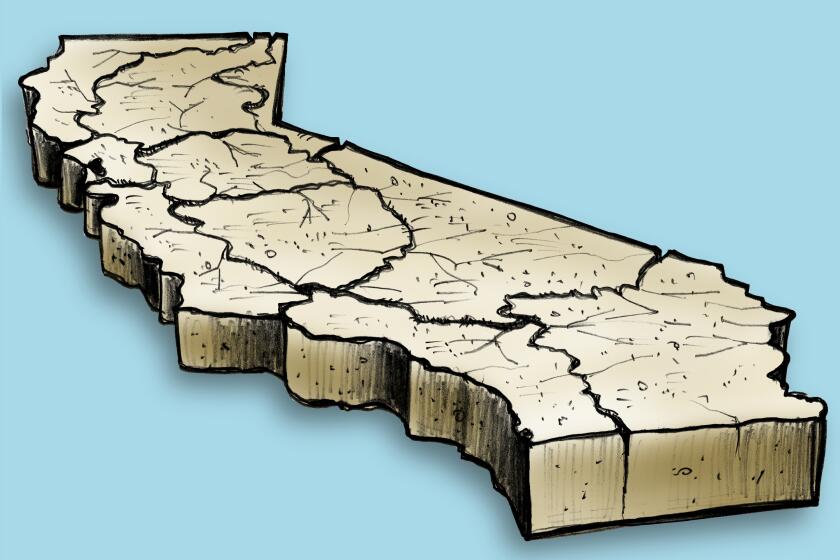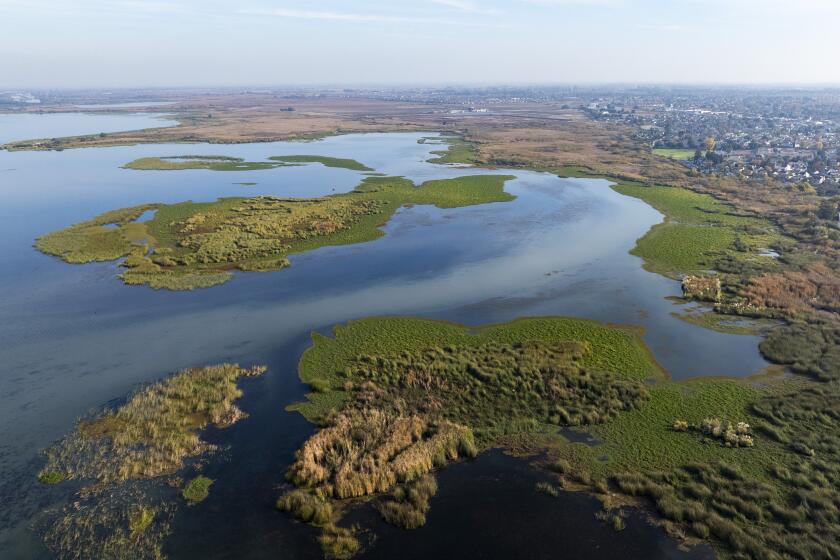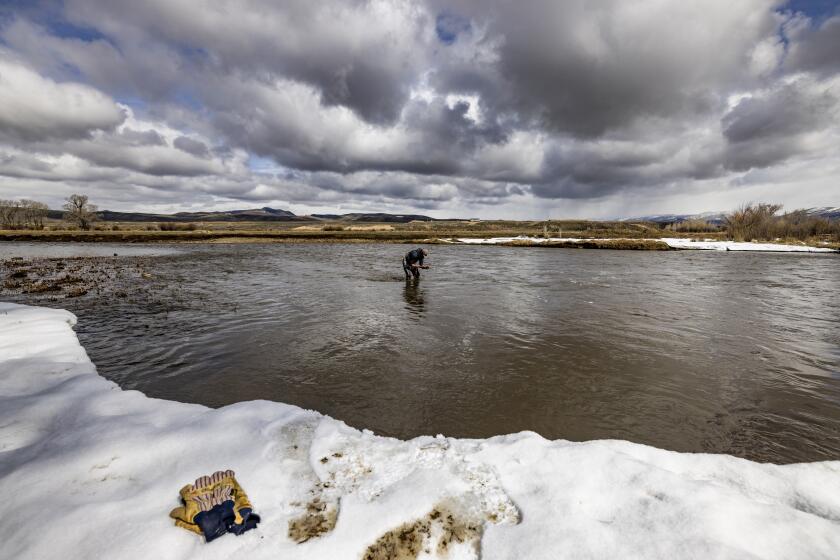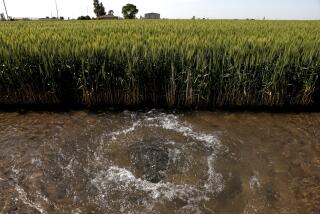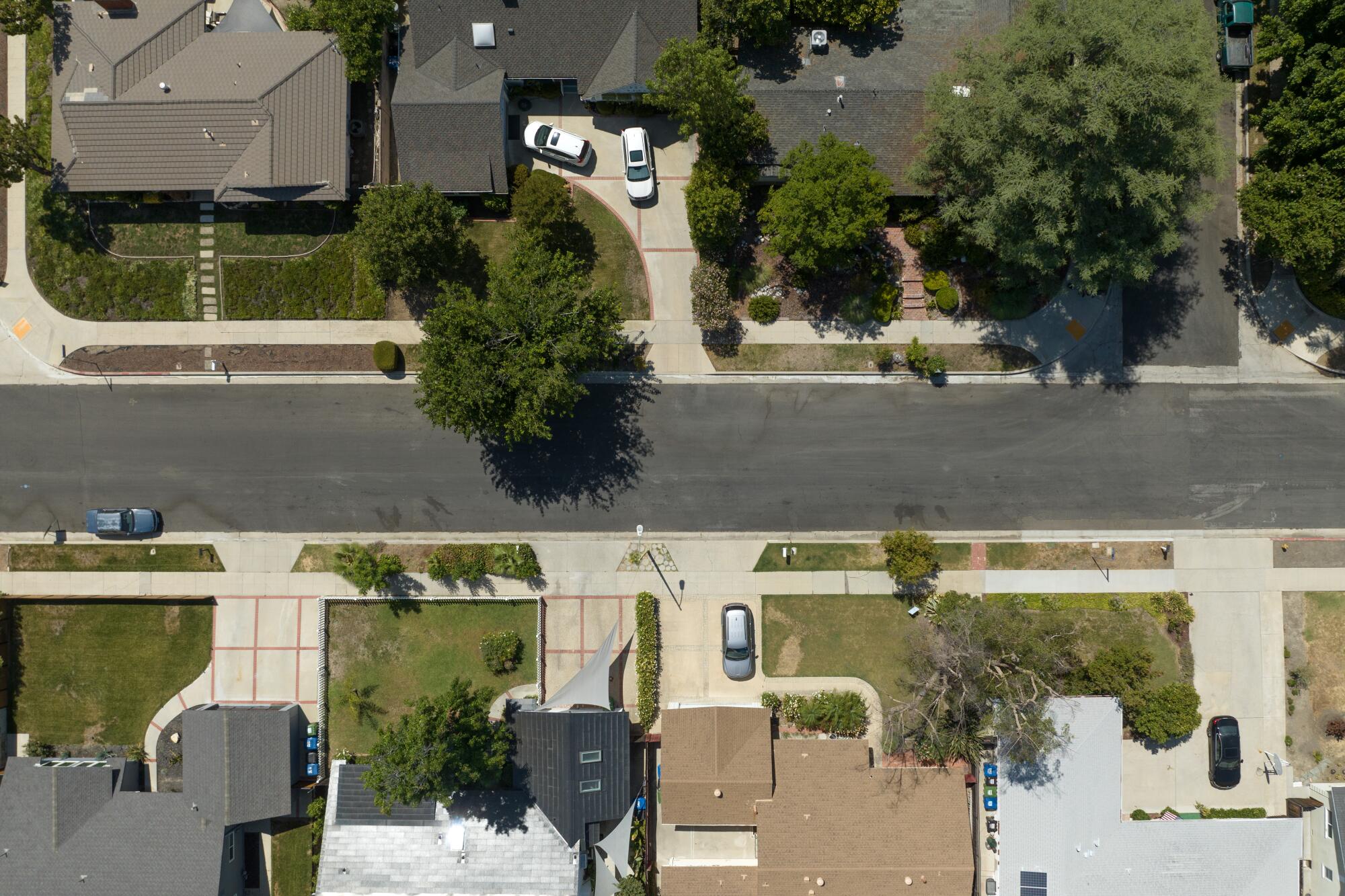
- Share via
After facing criticism, California water regulators have proposed new conservation rules that would ease requirements for urban suppliers and lead to smaller statewide water savings than originally planned.
An initial proposal from the State Water Resources Control Board ran into strong opposition last year, with managers of water agencies arguing that the large proposed cuts in water use between 2025 and 2035 would be costly and difficult to implement. Those criticisms were echoed in a scathing review by the nonpartisan Legislative Analyst’s Office.
In response, the state water board’s staff rewrote its blueprint for regulations, proposing less stringent water-saving standards while reducing the number of suppliers that would be required to achieve large cuts of more than 20% and extending the timeline for water reductions an additional five years to 2040.
If approved by the state board later this year, the proposed regulations, dubbed “Making Conservation a California Way of Life,” would apply to about 400 urban water suppliers, requiring them to adopt water-use budgets and meet locally tailored conservation goals. The latest changes would bring smaller mandatory reductions for many water agencies than had been expected, and would give them more time to take steps to decrease water usage.
“We’ve provided additional flexibility that adds to the overall budgets of many of the suppliers,” said Eric Oppenheimer, the state water board’s executive director. The new proposal, he said, “maintains the state’s commitment to conservation while making it easier for water suppliers to meet their efficiency goals.”
Aggressive and impactful reporting on climate change, the environment, health and science.
The changes were praised by representatives of local water agencies as a more reasonable approach. But conservation advocates criticized the revisions as a major watering down of rules that are supposed to help California adapt to the worsening effects of climate change.
“The revised regulation makes our communities less resilient to climate change and allows water suppliers to continue a business-as-usual path,” said Tracy Quinn, president and chief executive of the group Heal the Bay. “This approach is shocking considering what we know about changing precipitation patterns and California’s lip service about preparing for climate change.”
Quinn said the rules as proposed would fall far short of the steps California needs to take to adapt to more intense droughts and less reliable water supplies. She said the state water board “caved to unreasonable water agency complaints” by allowing weak standards with “semi-truck sized loopholes that make it too easy for water suppliers to shirk their obligation to use water more efficiently.”
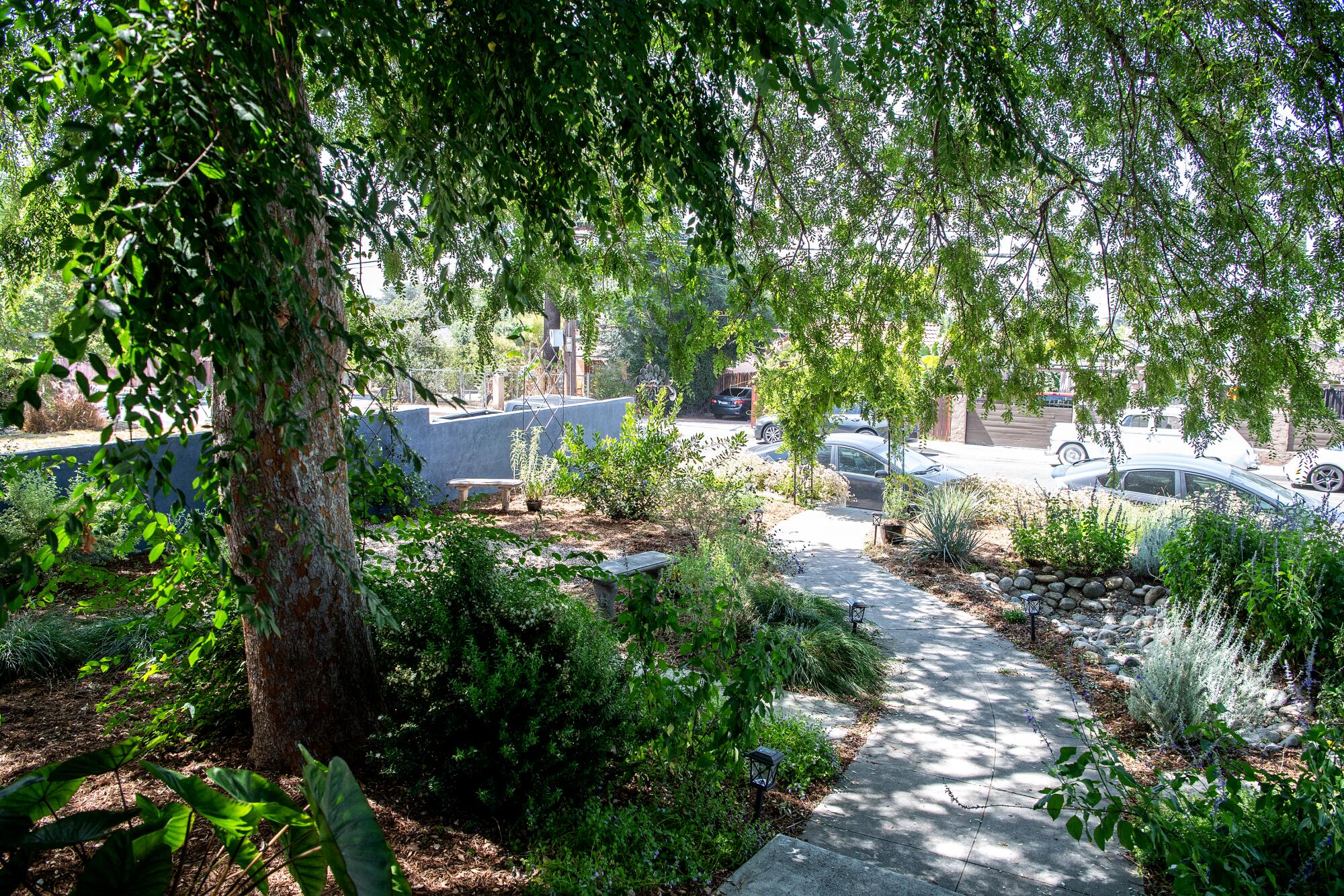
State officials said their revisions were based on extensive input from managers of water agencies and the public.
Many local water suppliers “raised a lot of concerns with the first draft of the regulation,” Oppenheimer said. “We really took stock in those comments that we received, and really took the concerns that were raised to heart.”
In November, state officials formed a group of water managers and conservation experts to discuss options for revising the regulations and held a series of meetings, where Oppenheimer said officials heard “a lot of really useful and meaningful input.”
The latest maps and charts on the California drought, including water usage, conservation and reservoir levels.
State regulators also considered the critique by the legislative analysts, who warned that the original proposal would be expensive, overly complicated and difficult to implement.
“Generally what we did was push out all of the dates about five years to provide more flexibility,” Oppenheimer said. “This provides additional time for the suppliers to meet those increasingly more efficient water use objectives.”
The regulations, which were required under 2018 legislation, are expected to take effect in January 2025, and the state would begin to assess whether suppliers are complying in 2027. The targets for reductions in water use would be phased in until 2040.
State officials had estimated that their original proposal would have slashed California’s urban water use 12% by 2035. With the changes, the state estimates the revised rules could reduce water use by 7% by 2035, and 9% by 2040.
The state board’s staff calculated those estimates using a baseline period of 2017 to 2021 for comparison, and found that the 2040 reduction goals would mean a statewide reduction of about 500,000 acre-feet of water per year, roughly equivalent to the annual water use of Los Angeles.
State officials acknowledged that some of these reductions would be expected to occur even without the regulations in place. They also said their estimates don’t account for measures in the proposal that would give some suppliers additional time to meet water-saving targets.
The number of water suppliers required to achieve reductions of more than 20% would decrease from 165 under the initial proposal to 108 under the new proposal. Of those, the number of agencies required to cut water use more than 30% would shrink from 84 to 47.
The rules would bring vastly different requirements for cities in Southern California.
On the high end of reductions, Arcadia would be required to cut water use 37.6% by 2040, while Beverly Hills would need a 34.6% reduction and Burbank would be tasked with a 32.4% reduction.
Elsewhere, the 2040 reductions would be 29.1% for Covina, 17.8% for Redlands, 15.7% for Thousand Oaks and 9.3% for the L.A. Department of Water and Power.
In all, 274 water suppliers statewide would be required to reduce water consumption by some amount by 2040.
In some areas, water purveyors are already meeting their long-term conservation targets. The rules would require no reduction in usage for 122 water agencies — an increase from 71 agencies under the initial plan — representing nearly a third of the state’s urban suppliers.
Among the cities that would not see any mandatory reductions in water use through 2040, according to state data, are Santa Ana and Compton.
The proposed changes address concerns raised by the Assn. of California Water Agencies, which represents public agencies that supply most of the state’s cities and farms.
Chelsea Haines, the association’s regulatory relations manager, said the state has now offered a “more reasonable yet strong regulation that will continue to push Californians to advance long-term water use efficiency.”
The new urban water efficiency rules are intended to drive permanent reductions to adapt to climate change — part of Gov. Gavin Newsom’s strategy to prepare for an estimated 10% decrease in California’s water supply by 2040.
“Urban retail water suppliers see water use efficiency as an important tool in the state’s strategy for adapting to climate change,” Haines said. “Our focus has been just making sure that the regulation that’s ultimately adopted puts us on a path of success that is cost effective, that is feasible, that provides adequate time for Californians to make the shifts that would be required.”
The state’s updated proposal, Haines said, will “provide more flexibility on how to achieve those goals, and recognizes that increasing long-term water use efficiency will require time.”

The proposed regulations won’t apply to individual households or businesses, only to cities and water districts. The rules also don’t apply to agriculture.
Under the regulations, each water supplier will be tasked with working toward a locally tailored water use budget, which accounts for indoor and outdoor residential water use, water lost to leakage, and landscape irrigation at businesses and institutional properties. Each city or water district can choose how to meet its overall water use goal.
There are special allowances for communities where residents have livestock, or where many homes have swamp coolers that consume more water.
The rules also include bonuses that would increase water budgets for suppliers that use recycled water, or for those that are struggling to meet targets and have non-irrigated areas that could be irrigated in the future.
In addition, the state’s proposal would allow some suppliers that are facing large reductions in water use to apply for “alternative compliance.” Based on current data, this would allow as many as 63 suppliers serving lower-income areas to reduce water use at the slower pace of 1% each year while working toward reduction goals. An additional 19 suppliers in higher-income areas would also qualify and could reduce water use 2% each year.
The state water board has the authority to issue orders if suppliers fail to comply, and to impose fines if necessary — up to $1,000 a day in a non-drought year, and $10,000 a day in a drought year. State officials say, however, that fines would be a last resort and they plan to work with local agencies to help them meet their targets.
The Delta Conveyance Project is a key component of Gov. Gavin Newsom’s strategy for a hotter, drier California. Opponents say it will be an ecological disaster.
Quinn, of Heal the Bay, said the expanded loopholes, delayed timeline and less stringent standards in the state’s proposal would be irresponsible and “reckless.”
“The proposed delay means the majority of water suppliers don’t have to save a single new drop of water until at least 2035,” Quinn said.
Quinn said she is concerned that the regulations as written would allow for “backsliding” and that some suppliers could increase water use. The 2018 legislation that laid the groundwork for the rules included a provision aimed at ensuring a previous goal of reducing water use 20% by 2020 would remain the minimum goal for all local agencies.
“Unfortunately, the State Board has decided not to enforce the no backsliding provision until 2040, meaning water suppliers can use more water than their 2020 goals for the next 16 years,” Quinn said.
Quinn said the “alternative compliance” measure, which was originally intended to help disadvantaged communities catch up on saving water, shouldn’t be used to ease the requirements for any supplier that hasn’t adequately invested in conservation.
“We need to be adapting our communities to climate change, and we needed to start yesterday — or a decade ago,” Quinn said. “Water agencies should be leaning into conservation and efficiency instead of fighting for the right to waste more water.”
Quinn pointed out that during the drought in 2022, parts of Southern California were under severe water restrictions, which were lifted only after the wet winter of 2023 ended the emergency.
“Our climate amnesia is almost as devastating as climate whiplash,” Quinn said. “The recent rain and snow seems to have faded our memories that just two years ago parts of Los Angeles were dangerously close to running out of water. Now is not the time to take our foot off the pedal.”
The Colorado River is approaching a breaking point, its over-tapped reservoirs dropping. Years of drying have taken a toll at the river’s source in the Rockies.
She and other advocates say conservation is the fastest and cheapest way of securing water supplies for cities, and that moving to change landscapes from thirsty lawns to native plants can help California not only become more resilient but also reduce energy use by pumping and treating less water.
A study in 2022 by researchers at the Pacific Institute, a water think tank in Oakland, found that California could reduce urban water use by 30% to 48% by investing in measures to use water more efficiently, such as fixing leaks in pipes, replacing inefficient appliances and replacing lawns with low-water-use plants. And experts say that from now until 2026, water districts have an opportunity to take advantage of federal funds from the Bipartisan Infrastructure Law to support investments in conservation efforts.
“California has a tremendous untapped potential to reduce urban water use,” said Heather Cooley, the Pacific Institute’s research director. “Now is exactly the time for the water board to push to ensure urban water conservation remains a priority.”
The state water board will hold a workshop on the proposed draft regulation March 20 and will accept comments until March 27.
Meanwhile, some water districts that are facing significant reductions — including Walnut Valley Water District, Rowland Water District and Bellflower-Somerset Mutual Water Co. — announced that they are supporting SB 1330, a bill introduced by state Sen. Bob Archuleta (D-Pico Rivera) that they say would make it easier to meet conservation goals. The districts’ managers said they are supporting the legislation to extend timelines for compliance, simplify procedures and ensure water remains affordable while they promote conservation.
The Assn. of California Water Agencies has not taken a position on the legislation.
Californians have dramatically reduced water use over the last decade. According to the state water board, per-capita urban water use decreased by more than 20% between 2013 and 2022.
Oppenheimer said the new rules would secure a significant amount of additional water savings.
“The state is facing major water supply challenges in the face of climate change,” he said. “And conservation is an important tool to help mitigate that reduction in water supply.”

